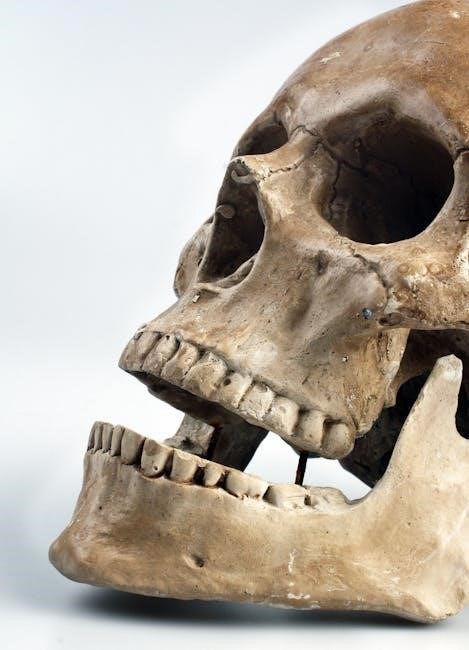
final exam biology study guide
Biology Final Exam Study Guide: A Comprehensive Plan
Conquer your biology final! This comprehensive guide provides a structured approach to studying. Review key concepts, practice with questions, and utilize available resources. Focus on understanding, not just memorization, for exam success. Prepare effectively by organizing your notes and identifying weak areas.

Scientific Method
Mastering the scientific method is crucial for your biology final. Remember its core steps: Observation, Question, Hypothesis, Experiment, Data Analysis, and Conclusion. The scientific method isn’t just a process; it’s a framework for critical thinking. Refine your understanding by applying it to real-world examples. Practice identifying each step in experimental scenarios. Learn to distinguish between a hypothesis and a null hypothesis. Understand the importance of controlled experiments and data interpretation. Consider the role of retesting and replication in validating findings.
Furthermore, remember that experimental design relies on proper controls and variables. It provides a structured approach to investigate phenomena, ensuring results are reliable and valid.
Applying the scientific method involves making careful observations. Then, based on these observations, form a testable explanation. After defining it, design an experiment to test the validity of the hypothesis. Analyzing data collected during the experiment helps draw conclusions. These conclusions will either support or reject the initial hypothesis. This iterative process strengthens our understanding of the natural world, which is essential for success in biology!
Identifying Variables (Dependent & Independent)

Successfully navigating your biology final requires a firm grasp of variables. Specifically, you need to understand dependent and independent variables. The independent variable is the factor you manipulate or change in an experiment. Conversely, the dependent variable is the factor you measure; it’s influenced by the independent variable. Think of it as cause and effect. If you change X (independent), what happens to Y (dependent)?
Consider a plant growth experiment. The amount of sunlight is the independent variable. The plant’s height, which you are measuring, is the dependent variable. A good experiment must have a control group. This group does not receive the experimental treatment. This allows comparison to the experimental group. This group receives the manipulated independent variable.
Practice identifying variables in different experimental scenarios. This skill is crucial for interpreting research and designing your own experiments. Remember, accurately identifying variables is essential for drawing valid conclusions. Furthermore, confounding variables should be considered. These are factors that could influence the dependent variable, skewing results. Understanding these concepts will significantly improve your exam performance and your overall understanding of scientific research.
Major Body Systems and Functions
Your biology final likely covers major body systems. Understanding each system’s primary function is crucial. The circulatory system transports oxygen, nutrients, and hormones. The respiratory system facilitates gas exchange. The digestive system breaks down food for energy. The nervous system controls communication via electrical and chemical signals. The endocrine system regulates processes through hormones. The skeletal system provides structure and support. The muscular system enables movement.
The excretory system eliminates waste products. The immune system defends against pathogens. The reproductive system enables procreation. Know the key organs within each system. Understand how these systems interact to maintain homeostasis. For instance, the nervous and endocrine systems often work together. They regulate bodily functions. The digestive and circulatory systems cooperate. They distribute nutrients obtained from food.
Focus on understanding the connections between systems. Don’t just memorize isolated facts. Consider how a disruption in one system affects others. For example, a respiratory issue impacts oxygen delivery. This affects cellular respiration in all tissues. This holistic approach will deepen your knowledge and help you succeed on your exam. Furthermore, understanding these systems is fundamental to understanding human health and disease.

Homeostasis and Negative Feedback
Homeostasis is the maintenance of a stable internal environment. This is despite external fluctuations. It’s essential for cell function and survival. Negative feedback is a primary mechanism for maintaining homeostasis. It works by counteracting changes to return a system to its set point. A sensor detects a deviation from the set point. A control center activates effectors to reverse the change. This brings the system back to equilibrium.
Consider body temperature regulation. If body temperature rises, sensors detect the change. The brain (control center) signals sweat glands (effectors) to produce sweat. Evaporation of sweat cools the body, lowering temperature. This returns it toward the set point. Conversely, if body temperature drops, shivering occurs. Muscles contract rapidly, generating heat. Blood vessels constrict, reducing heat loss.
Blood glucose regulation is another example. After eating, blood glucose rises. The pancreas releases insulin. Insulin promotes glucose uptake by cells. It also stimulates glucose storage as glycogen. This lowers blood glucose levels. When blood glucose drops too low, the pancreas releases glucagon. Glucagon stimulates the breakdown of glycogen. It releases glucose into the bloodstream. Understanding these mechanisms is key for your exam.
Cell Structure and Function
Cells are the basic units of life. They exhibit remarkable structural complexity. Understanding cell structure is crucial for grasping cellular function. Eukaryotic cells possess membrane-bound organelles. These include the nucleus, endoplasmic reticulum, Golgi apparatus, and mitochondria. The nucleus houses DNA and controls cell activities. The endoplasmic reticulum (ER) is involved in protein and lipid synthesis. The Golgi apparatus processes and packages proteins. Mitochondria are responsible for cellular respiration and energy production.
Prokaryotic cells lack membrane-bound organelles. Their DNA is located in the cytoplasm. Ribosomes are responsible for protein synthesis in all cells. The cell membrane regulates the movement of substances in and out of the cell. It consists of a phospholipid bilayer with embedded proteins.
Cellular functions include metabolism, growth, and reproduction. Metabolism involves chemical reactions that provide energy. Cell growth involves increasing in size and mass. Cell reproduction involves cell division, such as mitosis and meiosis. Mitosis produces identical daughter cells. Meiosis produces gametes with half the number of chromosomes. Understanding these structures and functions is essential for understanding biology. Be ready to identify organelles and explain their roles. Consider their function in cell processes.
Macromolecules: Carbohydrates, Lipids, Proteins, Nucleic Acids
Macromolecules are large organic molecules essential for life. Carbohydrates provide energy and structural support. They include monosaccharides, disaccharides, and polysaccharides. Glucose is a primary energy source for cells. Starch and glycogen are storage forms of glucose. Cellulose provides structural support in plants.
Lipids include fats, oils, and phospholipids. They are hydrophobic and serve as energy storage, insulation, and cell membrane components. Fats are composed of glycerol and fatty acids. Phospholipids form the cell membrane bilayer.
Proteins are composed of amino acids linked by peptide bonds. They perform a wide range of functions, including enzymes, structural components, and transport molecules. Enzymes catalyze biochemical reactions. Structural proteins provide support and shape. Transport proteins carry molecules across cell membranes.
Nucleic acids, DNA and RNA, store and transmit genetic information. DNA contains the instructions for building proteins. RNA plays a role in protein synthesis. Nucleotides are the building blocks of nucleic acids. They consist of a sugar, phosphate group, and nitrogenous base. Understanding the structure and function of these macromolecules is crucial for comprehending biological processes. Consider examples of each and their roles in cell functions. Also, review the building blocks of each macromolecule.
Genetics: DNA, RNA, and Replication
Genetics explores heredity and variation in organisms. DNA, deoxyribonucleic acid, carries genetic information; RNA, ribonucleic acid, assists in protein synthesis. Understanding their structure and function is essential. DNA’s double helix consists of nucleotides: adenine, guanine, cytosine, and thymine. Adenine pairs with thymine, and guanine pairs with cytosine. RNA uses uracil instead of thymine.
DNA replication duplicates the DNA molecule. The process is semi-conservative, producing two identical DNA molecules, each with one original and one new strand. Enzymes like DNA polymerase are crucial. Replication ensures genetic information is passed accurately to daughter cells during cell division.
Transcription converts DNA into RNA. RNA polymerase synthesizes mRNA (messenger RNA) using DNA as a template. mRNA carries genetic code from the nucleus to ribosomes for protein synthesis.
Translation decodes mRNA to assemble amino acids into proteins. Ribosomes bind to mRNA, and tRNA (transfer RNA) brings amino acids to the ribosome. Codons, three-nucleotide sequences on mRNA, specify which amino acid is added.
Central dogma: DNA -> RNA -> Protein. It describes the flow of genetic information. Mutations, changes in DNA sequence, can affect protein structure and function. Therefore, it is important to study the bases, and which ones connect.
Evolution and Taxonomy
Evolution describes the change in heritable characteristics of biological populations over successive generations. Natural selection, proposed by Charles Darwin, is a key mechanism. Organisms with advantageous traits are more likely to survive and reproduce, passing those traits to their offspring; This leads to adaptation and biodiversity. Evidence for evolution comes from fossils, comparative anatomy, embryology, and molecular biology.
Taxonomy is the science of classifying and naming organisms. It organizes the diversity of life into hierarchical groups based on evolutionary relationships. The Linnaean system uses binomial nomenclature: genus and species. The taxonomic ranks, from broadest to narrowest, are: Domain, Kingdom, Phylum, Class, Order, Family, Genus, and Species.
Phylogenetic trees illustrate evolutionary relationships among organisms. Branches represent lineages, and nodes represent common ancestors. Molecular data, like DNA sequences, are increasingly used to construct phylogenetic trees;
Understanding evolutionary history and taxonomic classification helps us understand the relationships between all living things. Evolution explains the unity and diversity of life, while taxonomy provides a framework for organizing and studying this diversity. Consider studying the origin of life, and how the earth was created.
Ecology: Ecosystems and Environmental Factors
Ecology is the study of interactions between organisms and their environment. An ecosystem includes all living organisms (biotic factors) in a particular area, as well as the non-living components (abiotic factors) with which they interact, such as sunlight, water, temperature, and nutrients.
Ecosystems are structured by feeding relationships. Producers (autotrophs) capture energy from sunlight through photosynthesis, forming the base of the food chain. Consumers (heterotrophs) obtain energy by feeding on other organisms. Decomposers break down dead organic matter, recycling nutrients back into the ecosystem. Food webs illustrate the complex network of feeding relationships within an ecosystem.
Environmental factors, both biotic and abiotic, influence the distribution and abundance of organisms. Temperature, water availability, sunlight, and nutrient levels are key abiotic factors. Biotic factors include competition, predation, and symbiosis.
Ecosystems are dynamic and constantly changing. Disturbances, such as fires, floods, and human activities, can alter ecosystem structure and function. Understanding ecological principles is crucial for managing and conserving biodiversity and ecosystem services. Remember that these are all interconnected, one change can affect the whole ecosystem.

Microscopy: Magnification and Field of View
Microscopy is an essential tool in biology, allowing us to visualize structures too small to be seen with the naked eye. Understanding magnification and field of view is critical for effective microscope use.
Magnification refers to the degree to which an object appears enlarged. Total magnification is calculated by multiplying the magnification of the objective lens by the magnification of the eyepiece lens (typically 10x). For example, a 40x objective lens combined with a 10x eyepiece yields a total magnification of 400x.
Field of view is the area visible through the microscope lens. As magnification increases, the field of view decreases. This is because you are focusing on a smaller portion of the sample. It’s important to start with a low magnification to locate your specimen, then increase magnification for detailed observation.
Remember, as magnification increases, the amount of light reaching your eye decreases, so you may need to adjust the light source. Also, higher magnification often requires finer focusing adjustments. Being proficient with these concepts is critical to excelling in biology, particularly when observing cells or organisms.